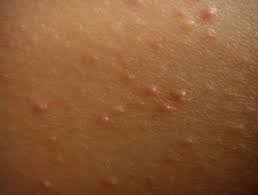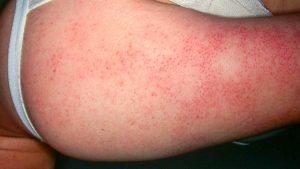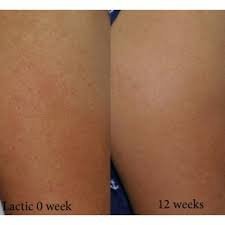Keratosis Pilaris, colloquially known as ‘chicken skin’, is a common skin condition that affects people of all ages worldwide. It is characterized by rough, small bumps on the skin that often resemble goosebumps or the skin of a plucked chicken, hence the nickname. This harmless condition typically affects the upper arms, thighs, and sometimes the face, but it can appear on other parts of the body. The skin condition, although benign, can be an aesthetic concern for many people. This article delves into the understanding and treatment options for Keratosis Pilaris.
Treating Keratosis Pilaris

Understanding Keratosis Pilaris
Keratosis Pilaris occurs due to an overproduction of keratin, a type of protein that protects the skin from harmful substances and infections. The excess keratin forms a scaly plug that blocks the opening of hair follicles, causing patches of rough, bumpy skin. This condition is not contagious and appears in both genders, although it seems to affect females more than males.
While the exact cause of Keratosis Pilaris is unknown, it often runs in families, indicating a genetic component. It can also flare up during periods of low humidity when the skin is dry, and it is more common in individuals with dry skin or eczema. Despite its prevalence, Keratosis Pilaris often improves with age and may even disappear completely in adulthood.

Managing Keratosis Pilaris
Currently, there is no known cure for Keratosis Pilaris, but various treatments can help reduce its symptoms. The primary aim of these treatments is to soften the keratin deposits in the skin. It is important to note that the effectiveness of treatment varies from person to person. Some may see improvement with basic skincare routines, while others might require more extensive treatment.
- Moisturizing: Regular moisturization is the first step in managing Keratosis Pilaris. Since the condition often worsens when the skin is dry, keeping the skin hydrated can minimize the symptoms. Look for moisturizers containing ingredients like urea, glycerin, or lactic acid, which can help exfoliate and soften the skin. Apply the moisturizer after bathing when the skin is still slightly damp to lock in moisture.
- Exfoliation: Gentle exfoliation can help remove keratin buildup on the skin’s surface. This can be achieved using a soft loofah or washcloth or by applying topical exfoliants that contain alpha or beta hydroxy acids, like glycolic acid or salicylic acid. However, be careful not to scrub too hard as it may irritate the skin and worsen the condition.
- Topical Retinoids: Topical retinoids, derived from vitamin A, can help promote cell turnover and prevent the hair follicle’s blockage. They may be particularly beneficial for persistent cases of Keratosis Pilaris. However, they can cause skin irritation and increase the skin’s sensitivity to the sun, so use them under the guidance of a dermatologist.

Medical Treatments
If self-care measures do not improve your skin’s condition, it might be time to seek medical treatments. Doctors can recommend or prescribe several treatments based on the severity of the condition.
- Prescription Creams and Lotions: Doctors may prescribe creams or lotions with higher concentrations of alpha-hydroxy acid, lactic acid, salicylic acid, or urea that aid in loosening and removing dead skin cells. They may also prescribe stronger retinoids if over-the-counter versions do not work.
- Laser Therapy: For severe or refractory cases of Keratosis Pilaris, laser therapy can be a feasible option. The intense pulsed light of lasers can help decrease the redness and inflammation associated with Keratosis Pilaris. However, the effectiveness of this method can vary, and multiple treatment sessions may be needed.

Living with Keratosis Pilaris
Living with Keratosis Pilaris can be challenging due to the cosmetic aspect of the condition. However, understanding that the condition is benign and quite common can help reduce anxiety. It’s important to remember that the condition often improves with age and is likely to disappear altogether over time. Additionally, maintaining a regular skincare routine and avoiding harsh soaps, hot water, and heavy scrubbing can help manage symptoms and prevent flare-ups.

Keratosis Pilaris is a common, harmless skin condition that can cause aesthetic discomfort to the individuals affected. Though it has no cure, numerous treatments can help manage and alleviate the symptoms. These treatments aim at softening the excess keratin buildup, reducing inflammation, and keeping the skin moisturized. Regular moisturizing, gentle exfoliation, topical treatments, and in some cases, medical treatments such as prescription creams and laser therapy can help improve the condition. However, remember that what works for one person may not work for another. Thus, it’s essential to be patient and persistently follow the treatment plan that suits your skin the best. Consult with a dermatologist to develop an effective treatment plan tailored to your needs.
Read More-

